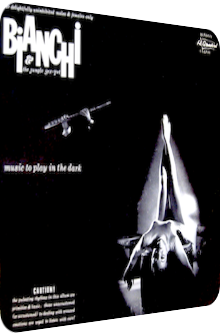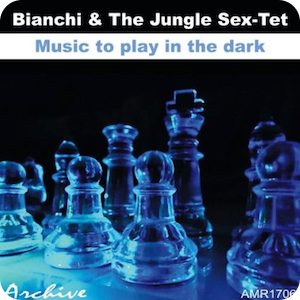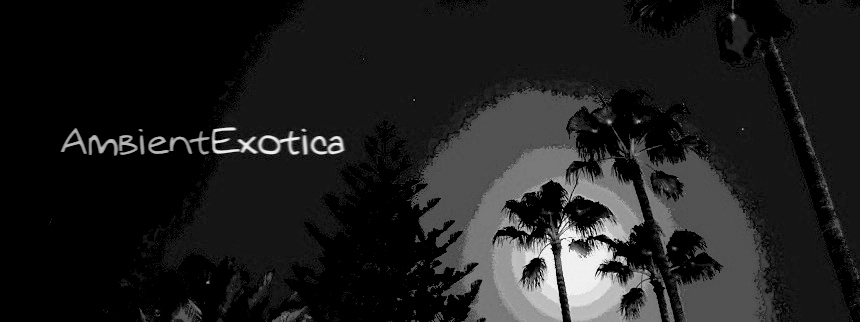
Bianchi & The Jungle Sex-Tet
Music To Play
In The Dark
1959
The title may not be overly fitting for reasons given at a later stage of this review, but even I am in awe if I read the band and album title out aloud: Bianchi & The Jungle Sex-Tet proudly present Music To Play In The Dark. Originally released in 1959 on the Hi-Standard label, Bianchi aka flutist Bob Romeo concocts a tropical Exotica work spanning 12 tracks: five of them originals, three of them renditions, with a whopping four additional ones deriving from the feather of Nature Boy Eden Ahbez, known for the curious but strikingly suitable blending of Exotica with the beatnik movement which eventually led to Eden’s Island (1960). Ahbez’s flavors of the Orient and the Age of Aquarius are not only merely adapted by Bianchi’s men, but cleverly altered.
The Sex-Tet comprises of bandleader Bob Romeo on the flute, Laurindo Almeida on the guitar, Eddie Cano on the piano, Rafael Vasquez, Jr. on the hardly featured bass guitar as well as bongo player Carlos Videl and timbalist Alvin Stoller. The original front artwork is one of the creepiest yet most lascivious ones to ever grace an Exotica record, multiplexing cavalcades of dubious lust which, in the end, are not resembled by any of the 12 tracks in the slightest. Music To Play In The Dark remains a great work and caters to an audience who favors a Latin frame and wants this skeleton to be expanded and intelligently improved. Here is a closer look at Bianchi’s LP which is introduced with the following words on the original front artwork: "For delightfully uninhibited males & females only."
 Come on, choose better stock photos for reissues. Although: it's dark after all.
Come on, choose better stock photos for reissues. Although: it's dark after all.
No need for a slow fade-in or a gentle glorification of life in the jungle: the opener Flute Hurricane throws the listener right into the green hell, one which is coincidentally encountering a stormy setting. The first of five originals to grace the album, Bianchi & The Jungle Sex-Tet kick off the table of contents with Alvin Stoller’s and Carlos Videl’s timbale-bongo parallax whirlwind, with Bianchi’s alto flute twirling through the interstices. Laurindo Almeida’s guitar twangs, meanwhile, seem hued in gold, hinting at the ultimately benign unfolding. Ritualistic and Pagan at its core, Flute Hurricane spawns melodies aplenty without becoming truly enchanting, letting this piece seem only to give an account for itself rather than to any other living soul; the epitome of a jungle. Bianchi’s second piece follows, Lonely Flute, a wondrous – and catchy – hybrid shuttling between Oriental snake charmer flute sequences and tramontane guitar melodies beyond the Adriatic mountains. Rafael Vasquez Jr.’s bass guitar twangs are shady, Laurindo Almeida’s leading foil is crimson-colored. These evening strings wind down the still freshly started album and impose a moiré.
While Nikolai Rimsky-Korsakov’s oft-considered Song Of India becomes a partially tribal affair due to the heavily clinging timpani but otherwise resides in Latin climes thanks to uplifting polyphonic flute coils and Eddie Cano’s warm-hearted insouciant piano beams, Lisbon Street Dance marks the first intrinsic instance of a song written by Eden Ahbez; marvelously sun-dappled and carefree, Almeida’s guitar shines in close proximity to the archetypically Latinized piano motif. Bianchi’s flute is silkened, Stoller’s timbales argentine. As Bianchi’s own Algiers overcomes its cinematic launch phase and is being transmuted into a Honky Tonk piano-backed memorable song for strolls through sun-lit jungle in large parts to the interplay between the accessible flute and Denny-esque piano effulgence, Esy Morales’ Exotica classic Jungle Fantasy rounds off the paradisiac side A with the expected tachycardia-sponsoring turmoil. With all hands on the bongos and timbales, the drummers have plenty of work to do in order to back the saltatory piano prongs and the ever-rising tone sequence close to the end.
Jungle Fifes blasts off side B in proper fashion. Envisioned by Bianchi, the titular fifes are small shrill flutes predominantly used in military bands and drum-accompanied marches. As such, the piece sports a wondrously hollow-murky beat resemblant of Ti-Marcel and Ti-Roro’s Voodoo Drums In Hi-Fi (1958), recorded on site in Port-au-Prince, Haiti. And indeed, an Haitian spirit also wafts through Bianchi’s tune, with the flute being piercing and quavering, but also strikingly luminous. Eden Ahbez’s Sahara follows, and not only does it foreshadow the writer’s – back then forthcoming – Eden’s Island tonality-wise, it also absorbs the frenzy of Esy Morales’ Jungle Fantasy and moulds it into a scorching desert as transformed via the rhythm-shifting parallax drums, the dun-colored Mediterranean guitar twangs and gyring flutes. A great tune! The follow-up Merry Flute is the last original composition by Bianchi, showcasing another frolicking upbeat mélange of frizzling timbales, bongo coppices and well-illumined cloudless skies as implied by the mercurial flutes and the memorable piano undercurrent. Resembling the worry-free lightness of The New York Jazz Quartet’s Gone Native (1957), this tune is a keeper as well.
The following tune is a real gem: the actually self-centered and pondering Zen by Eden Ahbez is transformed into a mildly hectic rufescent upper midtempo tune with a strong focus on Eddie Cano’s piano. Downwards spiraling, staccato-fied and gurgling along to the elasticized flute washes, the former focus on the innermost self is now taken to the street, so to speak. Highly bucolic while being seesawed in terms of its definite mood range, Zen shuttles between marvelously enchanting piano tones on the one hand, and slightly more dubious segues on the other. The sprinkler-like maracas and similarly coruscating timbales round off a great interpretation. Mineodardanella is next, a synergetic piece which draws from Bianchi’s own vivid imagination and the classic Dardanella by Fred Fisher, Felix Bernard and Johnny S. Black. This one is almost hilariously joyous, mimicking (or mocking?) a swinging piece with Eddie Cano’s Easy Listening piano prongs, Laurindo Almeida’s equally convivial guitar sections and Bianchi’s own four-note flute motif.
Side B closes the same way as side A, at least tempo-wise: Harold Weeks’ and Oliver Wallace’s Hindustan demands a lot of the drummers Alvin Stoller and Carlos Videl. Their performance is not over the top, but well sewn into the sun-coated piano jumpiness and the occasionally warbled but otherwise orderly played flute flumes. A good ending to a tropical record, emanating the carefree spirits one more time.
We’re talking about an Exotica record here, so deeper musings are elbowed away by 90% of all walkers who pass by in close proximity to this work one way or the other, but the question has to be asked regardless: why the album title? Music To Play In The Dark basks in light! Its darkest segments are expectedly pentatonic, but even these instances prove to be mere sunbursts. Bianchi aka Bob Romeo’s singular stop in the outskirts of Exotica, Afro-Bop and Jungle Jazz is a successful one. The Sex-Tet is valuable in the given context, and I cannot praise the importance of the two dedicated drummers highly enough. Similar to Bobby Montez’s quintet which also features a timbalist and conguero (the latter instead of a bongo player), Bianchi is able to use the manpower for all kinds of backdrops: demanding thickets, laid-back beats of soothingness and comparatively vivid sections in the fast lane.
We are not talking Sabu here, but the drums decidedly ameliorate the LP. They are probably most memorable in Jungle Fifes due to their echoey attack rate and equally reverberated decay. The drums aside, the flute is in the spotlight, true, but Music To Play In The Dark sports another important texture: Laurindo Almeida’s guitar. In tandem with pianist Eddie Cano, Almeida’s licks enshrine a cool vibe, are cautious foreboding devices of the Surf movement to come. Bianchi’s release is no must-have, but since it covers various Eden Ahbez productions and oscillates between Latin formations and the Middle East, it is a valuable – and recently digitally re-issued – jewel nonetheless.
Exotica Review 333: Bianchi & The Jungle Sex-Tet – Music To Play In The Dark (1959). Originally published on Apr. 19, 2014 at AmbientExotica.com.
